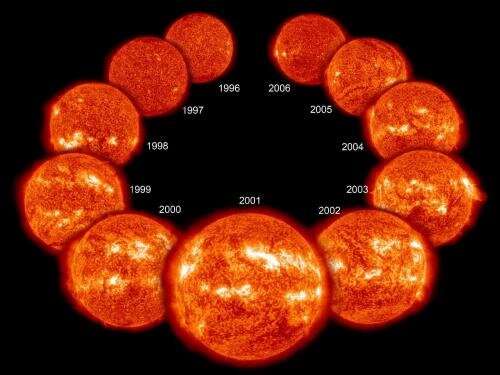
The number of sunspots on our sun varies from year to year, but one rare 70 year period has puzzled scientists for 300 years. A team of researchers at Penn State claim that a sun-like star has paused its own cycles and entered a similar period of rare starspots. Continuing to observe this star could help explain what happened to our own sun during this minimum, as well as lend insight into the sun's stellar magnetic activity, which can interfere with satellites and global communications and possibly even affect climate on Earth.
The star and a catalog of 58 other sun-like stars are described in a new paper.
The process that creates its magnetic field causes a starspot to appear as a dark spot on its surface. Astronomers have been documenting changes in starspot frequencies on our sun since Galileo first observed them in the 1600s, so there is a good record of its 11-year cycle. The Maunder minimum, which lasted from the mid 1600s to early 1700s, is the only exception.
Anna Baum, an undergraduate at Penn State at the time of the research and first author, said that they don't really know what caused the Maunder minimum, and have been looking at other sun-like stars to see if they can offer some insight. It will be really exciting to continue to observe this star during, and hopefully as it comes out of this minimum, which could be very informative about the sun's activity 300 years ago.
The research team pulled data from multiple sources. This included data from the Mount Wilson Observatory HK Project, which was designed to study stellar surface activity and ran from 1966 to 1996 and from planet searches at the Keck Observatory, which include this kind of data as part of their ongoing search for exoplanets from 1996 to 2020. The database of stars that appeared in both sources was compiled by the researchers. The team made a lot of effort to standardize the measurement from the different telescopes to be able to compare them directly and clean up the data.
The team confirmed that 29 of the stars have starspot cycles by observing at least two full periods of cycles. Some stars did not have cycles at all, which could be because they are rotating too slowly to have a dynamo and are dead, or because they are near the end of their lives. The stars need further study to confirm if they have a cycle.
The continuous, more than 50-year time series allows us to see things that we wouldn't have seen before, according to the author of the paper.
According to the researchers, the star HD 166620 was estimated to have a cycle of about 17 years but has now entered a period of low activity and no starspots since 2003
Jacob Luhn, a graduate student at Penn State, thought it was a mistake to pull together data from two different stars. The times of observation were in line with what we expected. Mount Wilson observed that there were not many bright stars in the sky. No matter how many times we checked, we always came to the conclusion that this star has stopped cycling.
The researchers hope to continue studying this star as it comes out of its minimum and begins to cycle again. This continued observation could provide important information about the sun and stars.
Baum said there was a big debate about the Maunder minimum. Did it lose its power? Was it still cycling but at a very low level? We can't go back in time to see what it was like, but if we can see the magnetic structure and magnetic field strength, we might start to get some answers.
There are several important implications of a better understanding of the sun's magnetic field. One particularly strong solar storm disabled a power grid in Quebec in 1989 because of stellar activity. It has been suggested that sunspot cycles may be related to climate. The researchers said that information from this star could affect our search for planets outside our solar system.
The ability to detect planets around stars is interfered with by spots and other forms of surface magnetic activity.
The starspot activity from this research has been made available for researchers to further investigate.
This research is a great example of cross-generational astronomy, and how we continue to improve our understanding of the universe by building upon the many observations and dedicated research of astronomer that came before us. We are looking forward to studying this and other promising stars.
More information: Anna C. Baum et al, Five Decades of Chromospheric Activity in 59 Sun-like Stars and New Maunder Minimum Candidate HD 166620, The Astronomical Journal (2022). DOI: 10.3847/1538-3881/ac5683 Journal information: Astronomical Journal Citation: Nearby star could explain why our sun didn't have sunspots for 70 years (2022, March 24) retrieved 24 March 2022 from https://phys.org/news/2022-03-nearby-star-sun-didnt-sunspots.html This document is subject to copyright. Apart from any fair dealing for the purpose of private study or research, no part may be reproduced without the written permission. The content is provided for information purposes only.